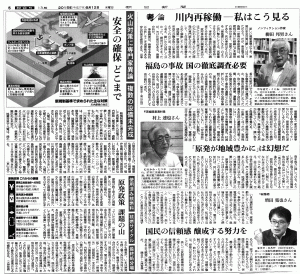Original Japanese written by staffer
The English below translated from the original Japanese by Heeday
The English translation edited by Rev. Dr. Henry French, ELCA
(Source: article of August 12th, 2015 edition of the Asahi Shimbun newspaper)

On August 11th, 2015, Kyushu Electric Power restarted its Sendai Nuclear Power Plant. Volcanology experts, however, are questioning the power company’s planned countermeasures against volcanic eruptions. And those concerns are not limited to parties in Japan. Many outside media are voicing their concerns as well.
Within 160km (100 miles) of the nuclear power plant lie 39 volcanos, including Sakurajima and Mt. Aso, which are quite active. A geological survey found that, in the past, some pyroclastic flows from major eruptions reached the vicinity of the Sendai Plant. A pyroclastic flow is one of those disasters that no nuclear power plant’s planning can prevent or counteract.
Kyushu Electric Power claims that the possibility is very small of a major eruption occurring during the lifetime of the Sendai Plant. Also, says the power company, if it perceives signs of a major eruption, it will stop the reactor and carry out the nuclear fuel. Most volcanologists say, however, that a major eruption hits Japan once in ten thousand years or so, which means that science has yet to learn what the signs of a coming major eruption are. Yet another serious problem is where the nuclear fuels will go if removed from the plant.
Moreover, in the vicinity of the Sendai Plant there are at least five major craters, which shows that there have been large-scale volcanic eruptions in the past. Especially notable is the one called Aira, which is the closest to the plant among all five – only 50km (31.3 miles) away. If this one erupts again, many volcanologists warn, it could result in sheer devastation.
Says Professor Ryusuke Imura, a volcanologist at Kagoshima University:
“In case an eruption causes a nuclear plant disaster, some radioactive substance will adhere to volcanic ashes and be carried around by the wind, until they fall on much of the Japanese archipelago. Also, in case of an ultra plinian eruption of a caldera [crater], the total volume of such descending ashes can be equivalent to the whole volume of Mt. Fuji, the greatest volcano of the archipelago. That gigantic volume of volcanic ashes, carrying radioactive substances, can fall down all over Japan. This is a possibility we cannot afford to ignore.”
If this should happen, it would certainly be the end of Japan.
In March 2011, TEPCO’s Fukushima Daiichi Nuclear Power Plant was devastated by the greatest tsunami in recorded history. We, residents in Japan, should have learned through our experiences of the earthquake-tsunami tragedy that a natural disaster can go far beyond our predictions.
I (the author) have learned through Fukushima tragedy that our ability to predict the scope of natural and human-made disasters is limited. Actual disasters can easily go well beyond our wildest imagination.
Today, many volcanoes are gently asleep. Yet they might “awake” and go active at any time. We cannot afford to allow the restart of nuclear power plants under the banner of “money first.”
We cannot depend on “good luck” if we are to enjoy peace and safety tomorrow. Rather, I am convinced that we need to build tomorrow’s peace and safety on a solid foundation by making the correct choices today.
